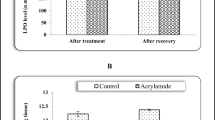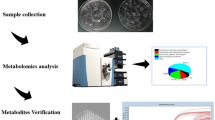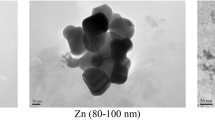Abstract
Lithium (Li) is a toxic monovalent alkaline metal used in household items common to industrial applications. The present work was aimed at investigating the potential toxic effects of LiCl on the redox status, fatty acid composition, and histological aspects of the marine ragworm Perinereis cultrifera. Sea worms were exposed to LiCl graded doses (20, 40, and 80 mg/L) for 48 h. Compared with the control group, the saturated fatty acids (SFA) decreased while monounsaturated (MUFA) and polyunsaturated fatty acids (PUFA) increased upon exposure to LiCl. The increase in PUFA n-3 and PUFA n-6 was concomitant to an increase in docosahexaenoic (DHA: C22:6n-3), eicosapentaenoic (EPA: C20:5n-3), and docosapentaenoic acid (C22:5n-6) fatty acids. Results showed that LiCl-treated specimens accumulate lithium with increasing exposure gradient. Indeed, the exposure to LiCl doses promoted oxidative stress with an increase of the ferric reducing antioxidant power (FRAP), malondialdehyde (MDA), hydrogen peroxide (H2O2), advanced oxidation protein product (AOPP), and protein carbonyl (PCO) as well as the enzymatic and non-enzymatic antioxidants (non-protein thiols (NPSH), catalase (CAT), superoxide dismutase (SOD), reduced glutathione (GSH), glutathione peroxidase (GPx), glutathione S-transferase (GST), and metallothionein (MT)) levels in all treated groups. Our biochemical findings have been affirmed by the histopathological observations showing hyperplasia and loss of the intestine structure in treated specimens. Overall, our findings give new insights on the toxic effect of LiCl on the redox status of P. cultrifera body tissue and highlighted the usefulness of the FA composition as an early sensitive bioindicators to better understand LiCl mechanism of toxicity in marine polychaetes.






Similar content being viewed by others
Data availability
Data and materials are available from the corresponding author on reasonable request.
References
Aebi H (1984) Catalase in vitro. Meth. Enzym 105:121–126. https://doi.org/10.1016/S00766879(84)05016-3
Albano GD, Gagliardo RP, Montalbano AM, Profita M (2022) Overview of the mechanisms of oxidative stress: impact in inflammation of the airway diseases. Antioxidants 11:2237. https://doi.org/10.3390/antiox11112237
Alderman CJJ, Shah S, Foreman JC, Chain BM, Katz DR (2002) The role of advanced oxidation protein products in regulation of dendritic cell function. Free Radic Biol Med 32:377–385. https://doi.org/10.1016/s0891-5849(01)00735-3
Ayala A, Muñoz MF, Argüelles S (2014) Lipid peroxidation: production, metabolism, and signaling mechanisms of malondialdehyde and 4- hydroxy-2-nonenal. Oxidative Med Cell Longev 2014:360438. https://doi.org/10.1155/2014/360438
Beauchamp C, Fridovich I (1971) Superoxide dismutase: improved assays and an assay applicable to acrylamide gels. Anal Biochem 44:276–277. https://doi.org/10.1016/00032697(71)90370-8
Bejaoui S, Bouaziz M, Ghribi F, Chetoui I, EL Cafsi M (2020) Assessment of the biochemical and nutritional values of Venerupis decussata from Tunisian lagoons submitted to different anthropogenic ranks. Environ Sci Pollut Res 27:1734–175110. https://doi.org/10.1007/s11356-019-06851-y
Bejaoui S, Chaâbane M, Chalbi E, Chalghaf M, El Cafsi M, Soudani N (2020) Exploring the impacts of mercury chloride exposure on fatty acids profile, oxidative stress response and histomorphological aspect of Cerastoderma edule detoxifying organs. Ecol Indic 118:106798. https://doi.org/10.1016/j.ecolind.2020.106798
Benzie IF, Strain JJ (1996) The ferric reducing ability of plasma (FRAP) as a measure of “antioxidant power”: the FRAP assay. Anal Biochem 239:70–76. https://doi.org/10.1006/abio.1996.0292
Berthet B, Mouneyrac C, Amiard JC, Amiard-Triquet C, Berthelot Y, Le Hen A, Mastain O, Rainbow PS, Smith BD (2003) Accumulation and soluble binding of cadmium, copper, and zinc in the polychaete Hediste diversicolor from coastal sites with different trace metal bioavailabilities. Arch Environ Contam Toxicol 45:468–478. https://doi.org/10.1007/s00244-003-0135-0
Birch NJ (2012) Lithium and the cell: pharmacology and biochemistry. Academic Press, New York
Bouhedi M, Antit M, Chaibi M, Perrein-Ettajani H, Gillet P, Azzouna A (2020) Assessment of trace element accumulation on the Tunisian coasts using biochemical biomarkers in Perinereis cultrifera. Sci Mar 85:91–102. https://doi.org/10.3989/scimar.05099.009
Bouraoui Z, Ghedira J, Boussetta H (2016) Biomarkers responses in different body regions of the polychaeta Hediste diversicolor (Nereidae, Polychaete) exposed to copper. J Integr Coast Zone Manag 15:371–376
Calder PC (2005) Polyunsaturated fatty acids and inflammation. Biochem Soc Trans 33:423–427. https://doi.org/10.1042/BST0330423
Cecchi G, Biasini S, Castano J (1985) Methanolyse rapide des huiles en solvants. Note de laboratoire. Rev Franc Corps Gras 4:163–164
Chetoui I, Bejaoui S, Trabelsi W, Rabeh I, Nechi S, Chelbi E, Chalghaf M, El Cafsi M, Soudani N (2019) Exposure of mactra corallina to acute doses of lead: effects on redox status, fatty acid composition and histomorphological aspect. Drugs Chem. https://doi.org/10.1080/01480545.2019.1693590
Da Costa F, Robert R, Quéré C, Wikfors GH, Soudant P (2015) Essential fatty acid assimilation and synthesis in larvae of the bivalve Crassostrea gigas. Lipids 50:503–511. https://doi.org/10.1007/s11745-015-4006-z
Dean HK (2008) The use of polychaetes (Annelida) as indicator species of marine pollution : a review. Revista De Biología Tropica 56:11–38
Draper HH, Hadley M (1990) Malondialdehyde determination as index of lipid peroxidation. Method Enzymol 86:421–431. https://doi.org/10.1016/0076-6879(90)
Dwyer RJ, Burch SA, Ingersoll CG, Hunn JB (1992) Toxicity of trace element and salinity mixtures to striped bass (Morone saxatilis) and Daphnia magna. Environ Toxicol Chem 11:513–520
Ellman GL (1959) Tissue sulhydryl groups. Archiv Biochem Biophys 82:70–77. https://doi.org/10.1016/0003-9861(59)90090-6
Fadhlaoui M, Couture P (2016) Combined effects of temperature and metal exposure on the fatty acid composition of cell membranes, antioxidant enzyme activities and lipid peroxidation in yellow perch (Perca flavescens) Aqua. Toxicol 180:45–55. https://doi.org/10.1016/j.aquatox.2016.09.005
Fauvel P (1927) Polychetes Sedentaires Faune de France, ed. Lechevalier, Paris, p 494
Filimonova V, Alves FG, Marques JC, Troch M, Gonçalves AMM (2016) Fatty acid profiling as bioindicator of chemical stress in marine organisms: a review. Ecol Indic 67:657–672
Flohe L, Gunzler WA (1984) Assays of gluthathione peroxidase. Meth Enzym 105:114–121. https://doi.org/10.1016/S0076-6879(84)05015-1
Fokina NN, Ruokolainen TR, Nemova NN, Bakhmet IN (2013) Changes of blue mussels Mytilus edulis L. lipid composition under cadmium and copper toxic effect. Biol Trace Elem Res 154:217–225. https://doi.org/10.1007/s12011-013-9727-3
Folch J, Lee M, Sloane Stanley GH (1957) A simple method for the isolation and purification of total lipides from animal tissues. J Biol Chem 226:497–509
Fouzai C, Trabelsi W, Bejaoui S, Telahigue K, Rabeh I, Nechi S, Chelbi E, El Cafsi M, Soudani N (2020) Cellular toxicity mechanisms of lambda-cyhalothrin in venus verrucosa as revealed by fatty acid composition, redox status and histopathological changes. Ecol Indica 108. https://doi.org/10.1016/j.ecolind.2019.105690
Fridovich I (1995) Superoxide radical and superoxide dismutases. Annu Rev Biochem 64:97–112. https://doi.org/10.1146/annurev.bi.64.070195.000525
Geracitano LA, Luquet C, Monserrat JM, Bianchini A (2004) Histological and morphological alterations induced by copper exposure in Laeonereis acuta (Polychaeta, Nereididae). Mar Environ Res 58:263–267. https://doi.org/10.1016/j.marenvres.2004.03.069
Ghirardini AV, Cavallini L, Delaney E, Tagliapietra D, Ghetti P, Bettiol C, Argese E (1999) H. diversicolor, N. succinea and P. cultrifera (Polychaeta: Nereididae) as bioaccumulators of cadmium and zinc from sediments: preliminary results in the Venetian lagoon (Italy). Toxicol Environ Chem 71:457–474
Ghribi F, Richir J, Bejaoui S, Boussoufa D, Marengo M, El Cafsi M, Gobert S (2020) Trace elements and oxidative stress in the Ark shell Arca noae from a Mediterranean coastal lagoon (Bizerte lagoon, Tunisia): are there health risks associated with their consumption? Environ Sci Pollut Res 27:15607–15623. https://doi.org/10.1007/s11356-020-07967-2
Greger R (1990) Possible sites of lithium transport in the nephron. Kidney Int 28:S26–S30
Guemouda M, Meghlaoui Z, Daas T, DaasMaamcha O, Scaps P (2014) Monitoring pollution in East Algerian coasts using biochemical markers in the polychaete annelid Perinereis cultrifera. Ann Biol Res 5:31–40
Gutteridge JM (1995) Lipid peroxidation and antioxidants as biomarkers of tissue damage. Clin Chem 41:1819–1828
Habig WH, Pabst MJ, Jakoby WB (1974) Glutathione S-Transferases: The first enzymatic step in mercapturic acid formation. J Biol Chem 249:7130–7139
Harper G, Sommerville R, Kendrick E, Driscoll L, Slater P, Stolkin R, Walton A, Christensen P, Heidrich O, Lambert S, Abbott A, Ryder K, Gaines L, Anderson P (2019) Recycling lithium-ion batteries from electric vehicles. Nature 575:75–86. https://doi.org/10.1038/s41586-019-1862-3
Hawrylak-Nowak B, Kalinowska M, Szymańska M (2012) A study on selected physiological parameters of plants grown under lithium supplementation. Biol Trace Elem Res 149:425–430
He L, He T, Farrar S, Ji L, Liu T, Ma X (2017) Antioxidants maintain cellular redox homeostasis by elimination of reactive oxygen species. Cell Physiol Biochem 44:532–553. https://doi.org/10.1159/00048508
Irato P, Santovito G (2021) Enzymatic and non-enzymatic molecules with antioxidant function. Antioxidants 10:579. https://doi.org/10.3390/antiox10040579
Kayali R, Çakatay U, Akçay T, Altuğ T (2006) Effect of alphalipoic acid supplementation on markers of protein oxidation in post-mitotic tissues of ageing rat. Cell Biochem Funct 24:79–85. https://doi.org/10.1002/cbf.1190
Kılıç GA (2018) Histopathological and biochemical alterations of the earthworm (Lumbricus Terrestris) as biomarker of soil pollution along Porsuk River Basin (Turkey). Chemosphere 83:1175–1180
Krumova K, Cosa G (2016) Chapter 1: Overview of reactive oxygen species, in Singlet oxygen: applications in biosciences and nanosciences, Volume 1, pp. 1-21. https://doi.org/10.1039/9781782622208-00001
Kszos LA, Stewart AJ (2003) Review of lithium in the aquatic environment: distribution in the United States, toxicity and case example of groundwater contamination. Ecotoxicology 12:439–447
Lewis C, Galloway T (2008) Genotoxic damage in polychaetes: a study of species and cell-type sensitivities. Mutat Res Genet Toxicol Environ Mutagen 654:69–75. https://doi.org/10.1016/j.mrgentox.2008.05.008
Liao B, Lu J, Hunang X, Guan L, Bai H, Zhang T (2018) Cloning and expression analysis of stearoyl-ACP desaturase gene PoSAD from Paeonia ostii. Acta Botan Boreali-Occiden Sin 38:35–40
Liu D, Gao L, Zhang Z, Tao S, Pang Q, Li A, Deng H, Yu H (2018) Lithium promotes the production of reactive oxygen species via GSK-3β/TSC2/TOR signaling in the gill of zebrafish (Danio rerio). Chemosphere 195:854–863. https://doi.org/10.1016/j.chemosphere.2017.12.130
Llesuy S, Evelson P, Campos AM, Liss E (2001) Methodologies for evaluation of total antioxidant activities in complex mixtures A critical review. Biol Res 34:51–73. https://doi.org/10.4067/s0716-97602001000200009
Long K, JrR B, Woodburn K (1998) Lithium chloride: a flow-through embryo-larval toxicity test with the fathead minnow, Pimephales promelas Rafinesque. Bull Environ Contam Toxicol 60:312–317
Los DA, Murata N (2004) Membrane fluidity and its roles in the perception of environmental signals. Biochim Biophys Acta 1666:142–157. https://doi.org/10.1016/j.bbamem.2004.08.002
Lv F, Nie Q, Wang T, Wang A, Yang W, Liu F, Yu Y, Lv L (2016) The effects of five dietary lipid sources on growth, body composition and antioxidant parameters of the clamworm, Perinereis aibuhitensis. Aquacult Res 48:5472–5480
Lowry OH, Roseborouch NI, Farrand AL, Randall RJ (1951) Protein measurement with the folin phenol reagent. J Biol Chem 263–275
Mao H, Wang DH, Yang WX (2012) The involvement of metallothionein in the development of aquatic invertebrate. Aquat Toxic 110:208–213. https://doi.org/10.1016/j.aquatox.2012.01.018
Monroig Ó, Kabeya N (2018) Desaturases and elongases involved in polyunsaturated fatty acid biosynthesis in aquatic invertebrates: a comprehensive review. Fish Sci 84:911–928. https://doi.org/10.1007/s12562-018-1254-x
Moore MN, Simpson MG (1992) Molecular and cellular pathology in environmental impact assessment. Aquat Toxicol 22:313–322
Neave MJ, Streten-Joyce C, Nouwens AS, Glasby CJ, McGuinness KA, Parry DL, Gibb KS (2012) The transcriptome and proteome are altered in marine polychaetes (Annelida) exposed to elevated metal levels. Proteomics 75:2721–2735. https://doi.org/10.1016/j.jprot.2012.03.031
Ou P, Wolff SP (1996) A discontinuous method for catalase determination at near 774 physiological concentrations of H2O2 and its application to the study of H2O2 fluxes within 775 cells. J Biochem Biophys Methods 31:59–67
Petrovic S, Ozretic B, Krajnovic-Ozretic M, Bobinac D (2001) Lysosomal membrane stability and metallothioneins in digestive gland of mussels (Mytilus galloprovincialis Lam.) as biomarkers in afield study. Mar Pollut Bullet 42:1373–1378. https://doi.org/10.1016/S0025-326X(01)00167-9
Pini JM (2014) An assessment of the impacts of chronic exposure of copper and zinc on the polychaete Nereis Alitta virens using an integrated ecotoxicological approach. University of Portsmouth, Thesis, p 293p
Radwan MA, El-Gendy KS, Gad AF (2010) Oxidative stress biomarkers in the digestive gland of Theba pisana exposed to heavy metals. Arch Environ Contam Toxicol 58:828–835. https://doi.org/10.1007/s00244-009-9380-1
Regoli F, Gorbi S, Frenzilli G, Nigro M, Corsi I, Forcardi S, Winston GW (2002) Oxidative stress in ecotoxicology: from the analysis of individual antioxidants to a more integrated approach. Mar Environ Res 54:419–423
Regoli F, Giuliani ME (2014) Oxidative pathways of chemical toxicity and oxidative stress biomarkers in marine organisms. Mar Environ Res 93:106–117. https://doi.org/10.1016/j.marenvres.2013.07.006
Reznick AZ, Packer L (1994) Oxidative damage to proteins: spectrophotometric methods for carbonyl assay. Meth Enzymol 233:357–363. https://doi.org/10.1016/S0076-6879(94)33041-7
Richir J, Gobert S (2014) The effect of size, weight, body compartment, sex and reproductive status on the bioaccumulation of 19 trace elements in rope-grown Mytilus galloprovincialis. Ecol Indic 36:33–47
Rocchetta I, Mazzuca M, Conforti V, Ruiz L, Balzaretti V, de Molina MDCR (2006) Effect of chromium on the fatty acid composition of two strains of Euglena gracilis. Environ Pollut 141:353–358
Rouhi A, Gillet P, Deutsch B (2008) Reproduction and population dynamics of Perinereis cultrifera (Polychaeta: Nereididae) of the Atlantic coast, El Jadida, Morocco. Cah Biol Mar 49:151–160
Ruocco N, Costantini M, Santella L (2016) New insights into negative effects of lithium on sea urchin Paracentrotus lividus embryos. Sci Rep 6:32157. https://doi.org/10.1038/srep32157
Salimi A, Gholamifar E, Naserzadeh P, Hosseini MJ, Pourahmad J (2016) Toxicity of lithium on isolated heart mitochondria and cardiomyocyte: a justification for its cardiotoxic adverse effect. J Biochem Mol Toxicol 0:1–8
Sapse AM, Schleyer PR (1995) Lithium chemistry: a theoretical and experimental overview. Wiley, New York
Schrauzer GN (2002) Lithium: Occurrence, dietary intakes, nutritional essentiality. J Am Coll Nutr 21:14–21
Shahzad B, Niaz Mughal M, Tanveer M, Gupta D, Abbas G (2017) Is lithium biologically an important or toxic element to living organisms? An overview. Environ Sci Pollut Res Int 24:103–115. https://doi.org/10.1007/s11356-016-7898-0
Sharma VJ, Satyanarayan S (2011) Effect of selected heavy metals on the histopathology of different tissues of earthworm Eudrillus eugeniae. Environ Monit Assess 180:257–267. https://doi.org/10.1007/s10661-010-1786-8
Silva CO, Simões T, Novais SC, Pimparel I, Granada L, Soares AMVM, Barata C, Lemos MFL (2017) Fatty acid profile of the sea snail Gibbula umbilicalis as a biomarker for coastal metal pollution. Sci Total Environ 15:542–550. https://doi.org/10.1016/j.scitotenv.2017.02.015
Singh N, Bhagat J, Ingole BS (2017) Genotoxicity of two heavy metal compounds: lead nitrate and cobalt chloride in Polychaete Perinereis cultrifera. Environ Monit Assess 189:308. https://doi.org/10.1007/s10661-017-5993-4
Snani M, Meghlaoui Z, Maamcha O, Daas T, Scaps P (2015) Laying period and biomarkers of the polychaete Perinereis cultrifera from the eastern coast of Algeria- Annaba-subjected to marine pollution. J Entomol Zool Stud 3:249–254
Soudani N, Troudi A, Ben Amara I, Bouaziz H, Boudawara T, Zeghal N (2012) Ameliorating effect of selenium on chromium (VI)-induced oxidative damage in the brain of adult rats. J Physiol Biochem 68:397–409. https://doi.org/10.1007/s13105-012-0152-4
Stachel SE, Grunwald DJ, Myers PZ (1993) Lithium perturbation and goosecoid expression identify a dorsal specification pathway in the pregastrula zebrafish. Development (cambridge, England) 117:1261–1274
Stampatori D, Raimondi PP, Noussan M (2020) Li-ion batteries: a review of a key technology for transport decarbonization. Energies 13:2638. https://doi.org/10.3390/en13102638
Telahigue K, Rabeh I, Hajji T, Trabelsi W, Bejaoui S, Chouba L, EL Cafsi M, Soudani N (2019) Effects of acute mercury exposure on fatty acid composition and oxidative stress biomarkers in Holothuria forskali body wall. Ecotoxicol Environ Safety 169:516–522. https://doi.org/10.1016/j.ecoenv.2018.11.051
Thibon F, Weppe L, Vigier N, Churlaud C, Lacoue-Labarthe T, Metian M, Yves Cherel P, Bustamante, (2021) Large-scale survey of lithium concentrations in marine organisms. Sci Total Envir 751:141453. https://doi.org/10.1016/j.scitotenv.2020.141453
Trabelsi W, Chetoui I, Fouzai C, Bejaoui S, Rabeh I, Telahigue K, Chalghaf M, El Cafsi M, Soudani N (2019) Redox status and fatty acid composition of Mactra corallina digestive gland following exposure to acrylamide. Environ Sci Pollut Res 26:22197–22208. https://doi.org/10.1007/s11356-019-05492-5
Trabelsi W, Fouzai C, Telahigue K, Chetoui I, Nechi S, Chelbi E, Zrellli S, Soudani N (2022) The potential adverse effects of acrylamide on the oxidative stress response, fatty acids profile, and histopathological aspect of the Mediterranean Holothuria forskali respiratory tree. Environ Toxicol 2022:1–13. https://doi.org/10.1002/tox.23674
Venkateswara Rao J, Surya Pavan Y, Madhavendra SS (2003) Toxic effects of chlorpyrifos on morphology and acetylcholinesterase activity in the earthworm, Eisenia foetida. Ecotoxicol Environ Saf 54:296–301
Viana T, Ferreira N, Henriques B, Leite C, De Marchi L, Amaral J, Freitas R, Pereira E (2020) How safe are the new green energy resources for marine wildlife? The case of lithium. Environ Pollut 267:115458. https://doi.org/10.1016/j.envpol.2020.115458
Viarengo A, Ponzano E, Dondero F, Fabbri R (1997) A simple spectrophotometric method for metallothionein evaluation in marine organisms: an application to Mediterranean and Antarticmolluscs. Mar Environ Res 44:69–84. https://doi.org/10.1016/S0141-1136(96)00103-1
Viarengo A, Burlando B, Cavaletto M, Marchi B, Ponzano E, Blasco J (1999) Role of metallothionein against oxidative stress in the mussel Mytilus galloprovincialis. Am J Physiol 277:1612–1619. https://doi.org/10.1152/ajpregu.1999.277.6.R1612
Weiner ML (1991) Overview of lithium toxicology. In: Schrauzer GN, Klippel KF (eds) Lithium in biology and medicine. VCH Verlag, Weinheim, pp 83–99
Yin Y, Sui C, Meng F, MaP JY (2017) The omega-3 polyunsaturated fatty acid docosahexaenoic acid inhibits proliferation and progression of non-small cell lung cancer cells through the reactive oxygen species-mediated inactivation of the PI3K/Akt pathway. Lipids Health Dis 16:87. https://doi.org/10.1186/s12944-017-0474-x
Acknowledgements
The authors are grateful to Mr. Hassen Mejri, technician of the Laboratory of Ecology, Biology and Physiology of Aquatic Organisms, for his assistance with gas chromatography analysis.
Author information
Authors and Affiliations
Contributions
F.G: investigation, conceptualization, methodology, formal analysis, writing original draft, writing, review, and editing. S.B: investigation, conceptualization, methodology, formal analysis, and editing. R.Z: investigation, methodology, and formal analysis. W.T: investigation and formal analysis. M.M: formal analysis and software. I.C: investigation. A.C: supervision, resources, reviewing, and editing. N.S: conceptualization, methodology, supervision, reviewing, and editing. All authors read and approved the final manuscript.
Corresponding author
Ethics declarations
Ethics approval and consent to participate
Not applicable.
Consent for publication
Not applicable.
Competing interests
The authors declare no competing interests.
Additional information
Responsible Editor: Chris Lowe
Publisher's note
Springer Nature remains neutral with regard to jurisdictional claims in published maps and institutional affiliations.
Rights and permissions
Springer Nature or its licensor (e.g. a society or other partner) holds exclusive rights to this article under a publishing agreement with the author(s) or other rightsholder(s); author self-archiving of the accepted manuscript version of this article is solely governed by the terms of such publishing agreement and applicable law.
About this article
Cite this article
Ghribi, F., Bejaoui, S., Zupa, R. et al. New insight into the toxic effects of lithium in the ragworm Perinereis cultrifera as revealed by lipidomic biomarkers, redox status, and histopathological features. Environ Sci Pollut Res 30, 68821–68835 (2023). https://doi.org/10.1007/s11356-023-27223-7
Received:
Accepted:
Published:
Issue Date:
DOI: https://doi.org/10.1007/s11356-023-27223-7




